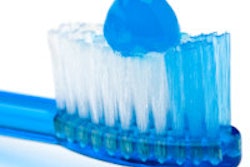
Power toothbrushes with a solid head retain significantly less bacteria compared with those with hollow heads, according to a new study in the Journal of Dental Hygiene (August 2014, Vol. 88:4, pp. 237-242).
"Toothbrushes can transmit microorganisms that cause disease and infections. A solid-head design allows for less growth of bacteria, and bristles should be soft and made of nylon," said lead study author Donna Warren Morris, RDH, MEd, a professor in the department of periodontics and dental hygiene at the University of Texas Health Science Center at Houston School of Dentistry, in a statement. "It is also important to disinfect and to let your toothbrush dry between uses. Some power toothbrushes now include an ultraviolet system, or you can soak the head in mouthwash for 20 minutes."
 Donna Warren Morris, RDH, MEd. Image courtesy of the University of Texas Health Science Center at Houston School of Dentistry.
Donna Warren Morris, RDH, MEd. Image courtesy of the University of Texas Health Science Center at Houston School of Dentistry.The researchers found that microbial counts were lower in the solid-head toothbrush group than in the two hollow-head toothbrush groups in nine out of 10 comparisons.
The study was conducted over a three-week period in which participants brushed twice daily with one out of three randomly assigned power toothbrushes. Participants used nonantimicrobial toothpaste and continued their flossing routine throughout the study, but they refrained from using other dental products such as mouthwash.
During the study, the brush heads were exposed to five categories of oral microorganisms: anaerobes and facultative microorganisms, yeast and mold, oral streptococci and oral enterococci anaerobes, Porphyromonas gingivalis, and Fusobacterium species.
After the three-week study period, the researchers collected the toothbrush heads and tested them in five different mediums: Brain Heart Infusion Agar (a general, nonselective microbial medium for anaerobes and facultative microorganisms); Yeast and Mold Agar (a selective medium for yeast and mold); Mitis Salivarius Agar (a selective medium for oral anaerobic streptococci and oral enterococci anaerobes); PGING AS 6422 (a selective medium for P. gingivalis); and FSA AS 6427 (a selective medium for anaerobic Fusobacterium species).
The study results showed that the solid-head power brush had fewer residual microorganisms in general than the brushes with hollow heads, the authors wrote. They speculated that the hollow-head brushes might provide more surface area for the microorganisms to form biofilms. This information could be especially important for immunosuppressed patients who are extremely vulnerable to pathogenic microorganisms such as Fusobacterium nucleatum, they noted.
No published studies have demonstrated that bacterial growth on toothbrushes can lead to systematic health effects, according to the study authors, but several microorganisms have been associated with systemic diseases, Morris noted.
"We do know and there are studies that have linked Fusobacterium to colorectal cancer. Some of these other bacteria have been linked with cardiovascular disease," Morris said. "There is a high association with gum disease and cardiovascular disease. Researchers have been able to culture the same bacteria around the heart that causes gum disease. "
However, as the authors noted, it is also possible that one of the brushes removed more bacteria on a daily basis, meaning there would have been fewer bacteria in the mouth to contaminate the brush.
Also, the small size of the study, participant compliance (self-reported), and toothbrush head design factors could have had effects on the outcomes, according to the authors. They suggested that future studies could control for these variables.
It can often be difficult for consumers to tell which is a hollow-head toothbrush and which is a solid-head toothbrush, Morris noted.
"The packaging on most power toothbrushes won't distinguish between a hollow-head and a solid-head design," she said. "The best way to identify a solid-head design is through the connection to the body of the power toothbrush. Naturally, there will be some space to connect the two parts but a significant portion will be solid, up to the bristles or brush head."



















